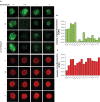Dual inhibition of anti-apoptotic proteins BCL-XL and MCL-1 enhances cytotoxicity of Nasopharyngeal carcinoma cells
- PMID: 35201512
- PMCID: PMC8814124
- DOI: 10.1007/s12672-022-00470-9
Dual inhibition of anti-apoptotic proteins BCL-XL and MCL-1 enhances cytotoxicity of Nasopharyngeal carcinoma cells
Abstract
One of the many strategies that cancer cells evade death is through up-regulation of the BCL-2 anti-apoptotic proteins. Hence, these proteins have become attractive therapeutic targets. Given that different cell populations rely on different anti-apoptotic proteins for survival, it is crucial to determine which proteins are important for Nasopharyngeal carcinoma (NPC) cell survival. Here we determined the survival requirements for the NPC cells using a combination of the CRISPR/Cas9 technique and selective BH3-mimetics. A human apoptosis RT2 Profiler PCR Array was first employed to profile the anti-apoptotic gene expressions in NPC cell lines HK-1 and C666-1. The HK-1 cells expressed all the anti-apoptotic genes (MCL-1, BFL-1, BCL-2, BCL-XL, and BCL-w). Similarly, the C666-1 cells expressed all the anti-apoptotic genes except BFL-1 (undetectable level). Notably, both cell lines highly expressed MCL-1. Deletion of MCL-1 sensitized the NPC cells to BCL-XL selective inhibitor A-1331852, suggesting that MCL-1 and BCL-XL may be important for NPC cell survival. Co-inhibition of MCL-1 and BCL-2 with MCL-1 selective inhibitor S63845 and BCL-2 selective inhibitor ABT-199 inhibited NPC cell proliferation but the effect on cell viability was more profound with co-inhibition of MCL-1 and BCL-XL with S63845 and A-1331852, implying that MCL-1 and BCL-XL are crucial for NPC cell survival. Furthermore, co-inhibition of MCL-1 and BCL-XL inhibited the growth and invasion of NPC spheroids. Deletion of BFL-1 sensitized NPC cells to A-1331852 suggesting that BFL-1 may play a role in NPC cell survival. Taken together co-inhibition of BCL-XL and MCL-1/BFL-1 could be potential treatment strategies for NPC.
Keywords: BCL-XL; BFL-1; BH3 mimetics; MCL-1; Nasopharyngeal carcinoma; Spheroids.
© 2022. The Author(s).
Conflict of interest statement
The authors declare no conflict of interest.
Figures




Similar articles
-
Single Agent and Synergistic Activity of Maritoclax with ABT-263 in Nasopharyngeal Carcinoma (NPC) Cell Lines.Trop Life Sci Res. 2020 Oct;31(3):1-13. doi: 10.21315/tlsr2020.31.3.1. Epub 2020 Oct 15. Trop Life Sci Res. 2020. PMID: 33214852 Free PMC article.
-
ABT-199-mediated inhibition of Bcl-2 as a potential therapeutic strategy for nasopharyngeal carcinoma.Biochem Biophys Res Commun. 2018 Sep 10;503(3):1214-1220. doi: 10.1016/j.bbrc.2018.07.027. Epub 2018 Jul 17. Biochem Biophys Res Commun. 2018. PMID: 30017199
-
Co-inhibition of BCL-XL and MCL-1 with selective BCL-2 family inhibitors enhances cytotoxicity of cervical cancer cell lines.Biochem Biophys Rep. 2020 Apr 22;22:100756. doi: 10.1016/j.bbrep.2020.100756. eCollection 2020 Jul. Biochem Biophys Rep. 2020. PMID: 32346617 Free PMC article.
-
Selective Bcl-2 Inhibitor Probes.2011 Oct 31 [updated 2013 Feb 28]. In: Probe Reports from the NIH Molecular Libraries Program [Internet]. Bethesda (MD): National Center for Biotechnology Information (US); 2010–. 2011 Oct 31 [updated 2013 Feb 28]. In: Probe Reports from the NIH Molecular Libraries Program [Internet]. Bethesda (MD): National Center for Biotechnology Information (US); 2010–. PMID: 23658956 Free Books & Documents. Review.
-
Small molecule Mcl-1 inhibitor for triple negative breast cancer therapy.Front Cell Dev Biol. 2024 Sep 20;12:1408107. doi: 10.3389/fcell.2024.1408107. eCollection 2024. Front Cell Dev Biol. 2024. PMID: 39372954 Free PMC article. Review.
Cited by
-
Ten Years of CRISPRing Cancers In Vitro.Cancers (Basel). 2022 Nov 23;14(23):5746. doi: 10.3390/cancers14235746. Cancers (Basel). 2022. PMID: 36497228 Free PMC article. Review.
-
Heparanase inhibitor OGT 2115 induces prostate cancer cell apoptosis via the downregulation of MCL‑1.Oncol Lett. 2024 Jan 5;27(2):83. doi: 10.3892/ol.2024.14217. eCollection 2024 Feb. Oncol Lett. 2024. PMID: 38249815 Free PMC article.
References
-
- Global Cancer Observatory: Cancer Today. Lyon, France: International Agency for Research on Cancer (IARC). https://gco.iarc.fr/today. Accessed 2 Nov 2021.
Grants and funding
LinkOut - more resources
Full Text Sources
Other Literature Sources
Research Materials
Miscellaneous
